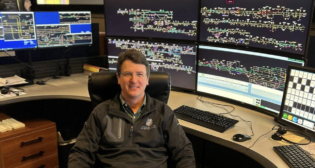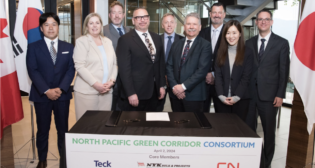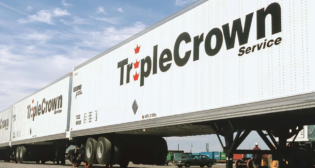
Bipartisan Surface Transportation Reauthorization Bill Debuts in Senate
Written by Marybeth Luczak, Executive EditorThe U.S. Senate Committee on Environment and Public Works (EPW) has released a draft $303.5 billion surface transportation reauthorization bill for fiscal years 2022-26, slated for mark-up on May 26.
The Surface Transportation Reauthorization Act of 2021 (download below) represents a 34% increase over the FAST (Fixing America’s Surface Transportation) Act, which expired in 2020 and Congress extended one year to Sept. 30, 2021.
The bill was announced May 22 by Sens. Tom Carper (D-Del.), Chairman of the EPW Committee; Shelley Moore Capito (R-W.Va), Ranking Member of the EPW Committee; Ben Cardin (D-Md.), Chairman of the EPW Subcommittee on Transportation Infrastructure; and Kevin Cramer (R-N.D.), Ranking Member of the Subcommittee.
Rail highlights of the Surface Transportation Reauthorization Act of 2021 include (download a section-by-section document below):
• Sec. 1108 will continue to set aside $245 million for the Highway-Rail Grade Crossing (Section 130) Program for each of fiscal years 2022-26. In addition, it removes the requirement that at least half of the funds “must be for the installation of protective devices” at crossings; increases the federal share of project funding from 90% to 100%; “clarifies that the replacement of functionally obsolete warning devices is an eligible expense”; increases the amount of “state incentive payment at-grade crossing closures” from $7,500 to $100,000; and “emphasizes eligibility for projects to reduce pedestrian fatalities and injuries from trespassing at grade crossings.”
• Sec. 1109 increases the amount of funding for the Surface Transportation Block Grant (STBG) Program’s Transportation Alternatives Program (TAP). The minimum percentage of TAP funding that is sub-allocated on the basis of population rises to 59%, and states may opt to increase that percentage to as high as 100%. It also adds new eligibilities to STBG, including “construction of wildlife crossing structures, electric vehicle charging infrastructure and vehicle-to-grid infrastructure, installation and deployment of intelligent transportation technologies, projects that facilitate intermodal connections between emerging transportation technologies, resilience features, cybersecurity protections, and rural barge landings, docks, and waterfront infrastructure projects, and the construction of certain privately owned ferry boats and terminals.”
• Sec. 1110 amends the Nationally Significant Freight and Highway Projects (NSFHP) program (aka, INFRA grant program) by raising the cap on eligible multimodal projects to 30% of the amounts made available for grants in each of fiscal years 2022-26. No more than 2% of total program funds may be set aside for grant application review, grant administration, and oversight by the National Surface Transportation and Innovative Finance Bureau (aka, Build America Bureau). This section provides $150 million per year of NSFHP funds for a pilot program that “prioritizes applications offering the greatest non-federal share of project costs”; increases the minimum amount that is reserved for small projects from 10% to 15%, and requires that not less than 30% of small project funds be used for rural areas; adds “freight resilience to natural hazards or disasters, such as high winds, heavy snowfall, flooding, rockslides, mudslides, wildfire, or steep grades as an additional consideration” for making grants; and includes wildlife crossings, surface transportation improvements functionally connected to an international border crossing, and marine highway projects functionally connected to the National Highway Freight Network as eligible projects.
• Section 1115 allows states to spend up to 10% of Congestion Mitigation and Air Quality Improvement Program (CMAQ) funds on “certain lock and dam modernization or rehabilitation projects and certain marine highway corridor, connector or crossings projects if such projects are functionally connected to the federal-aid highway system and are likely to contribute to the attainment or maintenance of a national ambient air quality standard.”
• Sec. 1124 consolidates programs, providing funding for Operation Lifesaver, work zone safety grants, and safety clearinghouses for fiscal years 2022-26.
• Sec. 1125 lists state freight advisory committee member qualifications.
• Sec. 1130 for public transportation adds eligibility for the construction of a bus rapid transit corridor or dedicated bus lanes.
• Section 1206 requires a study of “forecasted travel demand data compared to actual observed travel.” The findings would inform state and metropolitan planning organization (MPO) use of travel forecasting to “evaluate the impacts of transportation investments on travel demand, to support more accurate travel demand forecasting, and to enhance the capacity of states and MPOs to forecast travel and track observed travel behavior.”
• Section 1508 contains transparency requirements for projects carried out through public-private partnerships with an estimated cost of $100 million or more. “Specifically, this section requires that as a condition to receiving federal financial assistance for a project, a public partner must disclose and certify certain information relating to the private partner’s satisfaction of the terms of the public-private partnership agreement not later than three years after the date of the opening of the project to traffic.” In addition, it requires Congress to be notified when projects are carried out through public-private partnerships.
• Section 1513 requires a public notice 15 days before “issuing a waiver for the Buy America requirement for federal-aid projects” and an annual report to Congress on all such waivers.
• Section 2001 updates the Transportation Infrastructure Finance and Innovation Act (TIFIA) to “increase program utilization, streamline the application process for assistance, and increase transparency in the vetting process for projects seeking TIFIA funds.” This section adds “eligibility for public infrastructure located near transportation facilities to promote transit-oriented development subject to a Sept. 30, 2025 letter of interest deadline and a cap on the funding available for such projects.”
• Section 3002 directs the Department of Transportation Secretary, in coordination with the Secretary of the Treasury, to establish a pilot program to demonstrate a national motor vehicle per-mile user fee.
• Section 3010 establishes a transportation pilot program to “develop or procure an accessibility data set and make it available to each eligible entity selected to participate in the pilot program, to improve transportation planning. The pilot will measure the level of access by surface transportation modes to important destinations, which may include jobs, health care facilities, child care facilities, educational and workforce training facilities, housing, food sources, points within the supply chain for freight commodities, domestic and international markets, and connections between surface transportation modes. The pilot will assess the change in accessibility that would result from new transportation investments.”
“I’m proud to join with my colleagues in crafting a bipartisan bill that invests in our nation’s transportation infrastructure at a historic high level, and in doing so, helps create jobs, curbs our carbon emissions, and expands opportunities for the American people,” said Sen. Carper. “We must reauthorize the surface transportation bill before its current authorization expires in September. It is a vital foundation for President Biden’s American Jobs Plan. I look forward to continuing to work to transform our nation’s infrastructure and equip our economy for the future.”
“Not only will this comprehensive, bipartisan legislation help us rebuild and repair America’s surface transportation system, but it will also help us build new transportation infrastructure,” Sen. Capito said.
“This legislation includes support both for reducing emissions and improving resilience, as it should,” said Sen. Cardin. “There is much more work to be done to address the full spectrum of our infrastructure needs, but this measure decisively helps us begin to answer the president’s call to build back our infrastructure, better than ever.”



